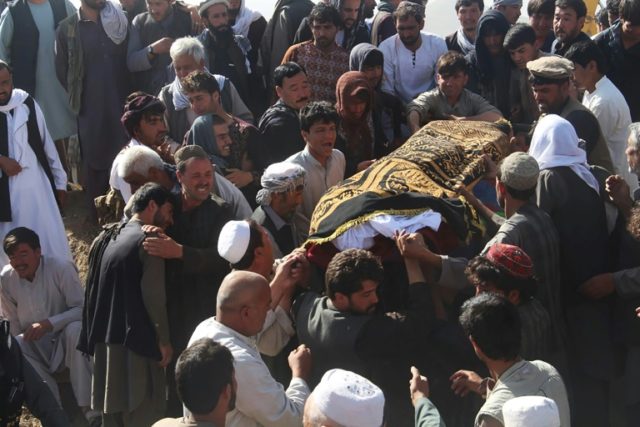A wave of attacks perpetrated by the Taliban, recently deemed by a U.S. government-linked study as the world’s second most lethal terrorist group, killed more than 30 people in Afghanistan since Sunday.
The killings came as negotiations begin between the United States and the ruthless narco-jihadis to end to the nearly 17-year-old war.
Fatalities at the hands of the Taliban include three NATO troops from the Czech Republic in Parwan province on Sunday, 14 policemen massacred in Ghazni province on Monday, and another four police officers killed Monday.
On Tuesday, the Associated Press (AP) highlighted more Taliban attacks:
A string of Taliban attacks in Afghanistan have killed 12 people, including four women who died in the crossfire during a shootout between insurgents and soldiers, while an errant NATO airstrike killed nine Afghan police, Afghan officials said Tuesday.
The Taliban attacked a military checkpoint in the western Farah province, killing four troops and wounding six, according to Mohammad Naser Mehri, the provincial governor’s spokesman. The attack in Bala Buluk district started late Monday night and lasted for several hours.
“The Taliban were pushed back, and the situation is under control now,” Mehri said, referring to the Taliban in Farah, which borders Iran.
According to the American military, U.S.-designated sponsor of terrorism Iran lends support to the Taliban against their mutual enemy the Islamic State (ISIS/ISIL).
Taliban attacks in Farah have intensified since U.S. President Donald Trump pulled out of the Obama-era Iran nuclear deal, which ended international sanctions in exchange for Tehran freezing its nuclear program.
In Farah province along the Iranian province, the Taliban attack this week came hours before President Trump reimposed a round of sanctions against Iran that went into effect early Tuesday.
Between Sunday and early Tuesday, the Taliban killed at least 33 people, including women, NATO troops, and members of the Afghan National Defense and Security Forces (ANDSF), which includes police and army units.
Taliban jihadists also wounded scores of other people.
“In the eastern Logar province, the four women were killed and four children were wounded in the crossfire during a shootout near Puli Alim, the provincial capital, said Hasibullah Stanikzai, a provincial council member. He said an investigation is underway to determine which side caused the civilian casualties,” the Associated Press reported.
Logar shares a border with a volatile Pakistani province.
For months, the Trump administration urged Pakistan to stop harboring terrorist groups fighting the U.S. and their allies in Afghanistan, to no avail.
The administration froze U.S. security aid over Islamabad’s reluctance to take decisive action against the Afghan Taliban and the al-Qaeda-linked Haqqani Network, considered by the Pentagon to be the top threat facing the United States in Afghanistan.
The Republican-led Congress has proposed completely slashing defense assistance by about 75 percent from $1 billion to $150 million.
According to the University of Maryland’s latest National Consortium for the Study of Terrorism and Responses to Terrorism (START) issued August 1, the Taliban was the second most deadly and prolific terrorist group in 2017, the latest year for which data is available.
Taliban jihadis carried out 907 attacks that killed 4,925 people, marking a slight drop from the previous year. Only core Islamic State (ISIS/ISIL) was deadlier than the Afghan Taliban.
START is linked to the U.S. Department of Homeland Security (DHS).
News reports surfaced over the last few days that the Trump administration budged on the Taliban’s long-held demand to directly negotiate the end of the Afghan war with the United States.
The Taliban also appeared to give an inch, reportedly expressing a willingness to allow a “residual” American force to remain in Afghanistan after the end of the conflict and recognizing a need to combat the intensified ISIS treat together.
Taliban terrorists have long maintained that U.S.-NATO troops must completely pull out of Afghanistan as a precondition to peace negotiations.
Despite recent reports that top U.S. Department of State Amb. Alice Wells directly negotiated with the Taliban in the group’s so-called political office in Qatar, U.S. Secretary of Defense James Mattis insisted to Pentagon reporters Tuesday: “The reconciliation effort [is] Afghan-owned, Afghan-led. We are working very closely with them in everything we are doing alongside our NATO allies, as we engage to try to end this war.”
Reconciliation between Kabul and the Afghan the Taliban is the primary goal of U.S. President Donald Trump’s South Asia strategy to end the war, which started in October 2001.

COMMENTS
Please let us know if you're having issues with commenting.